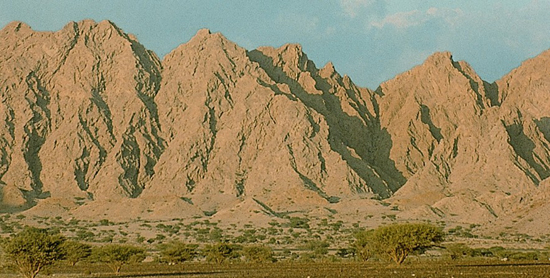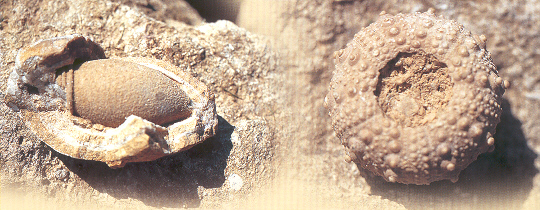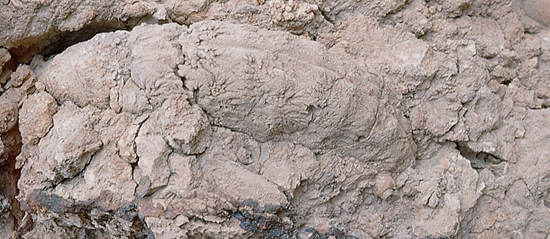|
In
the UAE the study of fossils has been done by both
amateurs and experts. The amateurs were mostly members
of the Emirates Natural History Groups, while the
experts were geologists working for the oil companies,
and later specialists who came over for special projects
organized by ADIAS – the Abu Dhabi Islands
Archaeological Survey. Between them, these groups have
uncovered an enormous amount of finds, many extremely
interesting.
In order to understand why
certain fossils can be found in certain places, it is
necessary to see how the land was formed.
The rigid outer
shell of the earth (the “lithosphere”) is fragmented
into plates that can move, propelled by “currents” in
the underlying layer. Plates can drift apart or closer
together, a process called tectonic movement. Where
tectonic plates meet, they can either grind along each
other’s edges, or they can be pushed under or over each
other (subduction and obduction).
Most oceans have
a ridge of volcanic mountains running along the centre.
Due to volcanic activity, such a ridge in the middle of
the ocean can split, forming a new part of the
lithosphere, the so-called oceanic crust. The two sides
drift apart, a process called seafloor spreading.
Some 140 million
years ago the continental plate of Africa split from
South America and started drifting towards the north
east, due to the sea-floor spreading along the
mid-Atlantic ridge. Much later, in the Cretaceous period
(70 million years ago) another rift (now known as the
Red Sea rift) began to break the link between what is
now Arabia and Egypt. At this time there was still a
connection between the Mediterranean and the Arabian
Gulf and Indian Ocean, the so-called Tethys seaway.
Volcanic activity along the Indian Ocean ridge pushed
oceanic crust up against the Arabian landmass and formed
what would later be the Hajar mountains. For a long time
these mountains were still partly covered by the sea. In
between islands that were the tops of these mountainous
structures there were shallow bays which supported a
unique diversity of invertebrate animals, ranging from
echinoids (sea urchins) to gastropods and corals.
Fossils of these marine organisms can be found in the
row of limestone mountains that lies parallel to the
Hajar mountains on its western flanks.
Approximately 23
million years ago Arabia had moved so far away from
Africa that the Tethys sea was closed. This movement
gave birth (amongst others) to the Zagros mountains of
Iran. Up until 5 million years ago (in late Miocene and
Pliocene times) there still existed a narrow land bridge
between Ethiopia in Africa and Yemen in Arabia, allowing
migration of terrestrial animals to and from Africa and
Asia via Arabia. At the time when these animals existed,
the climate in this western region of Abu Dhabi was
quite different from what it is now. Evidence has been
found of the existence of an area of deep fresh water
channels, where 4-meter long crocodiles, hippos and
catfish thrived. On the grassy plains between the
channels lived sabre-toothed cats, three-toed horses,
apes, hyenas and four-tusked elephants as well as
smaller mammals such as gerbils.
For the present
day it means that we can find marine invertebrate
fossils as old as 70 million years in the eastern part
of the UAE and fossils of terrestrial vertebrates at
least 5 million years old in the western region of Abu
Dhabi. This is a very unique situation to have in one
relatively small country. In fact, it is now known that
the UAE has the most diverse palaeontological heritage
of any country in the Arabian Peninsula. In the Musandam
region fossils have been found that are even older – 150
million years, but this area lies outside UAE borders.
Many of the
species of animals that once roamed the Emirates' region
have become extinct. In fact, it has been estimated that
all over the world, 98% of the species of animals that
lived at one time or another have become extinct. This
means that the rich diversity of animal species that we
still have at this present time represents only 2 % of
all that saw the light of day in the past. The sabre-toothed
tiger is no longer alive, and even the little gerbil,
whose teeth were found in the Baynunah sediments was a
species not known until now. In honour of the area where
it was found it has been called
Abudhabia baynunensis.

The study of the
UAE fossils began in earnest in 1979 when the late Peter
Whybrow, paleaontologist at the Natural History Museum
(UK), found a fossil of horse teeth in soft sandstone
near Jebel Dhanna. It belonged to the extinct species of
three-toed horse called Hipparion and was
subsequently dated to be about 16 million years old.
Horses in Europe do not occur until 11 millions years
ago, and it ios possible that they strayed to the north
west from Arabia.
Since Peter
Whybrow's first discovery, more than 35 years of
research have closely examined some 200 (out of a
possible 10.000) square kilometers of desert, extending
the area where fossils are found as far west as Rumaitha.
The rocks that have been examined have been divided into
the Shuwayhat formation and the Baynunah formation. The
former resulted from the fossilization of aeolian sands
and does not contain any fossils that can be used for
dating. However, the minerals contained in this
formation proved it to be around 14 million years old.
After these sands became rock, a river estuary developed
in the area now known as Sabkha Matti. The sands,
gravels and clays deposited by this river form the
Baynunah formation. Even though no complete skeletons of
any animal were found, the parts that were collected
gave enough information to make identifications. So far
the Baynunah formation has yielded 4 species of
invertebrates, 2 species of plants, 3 species of fish, 8
species of reptiles, 3 species of birds and 31 species
of mammals, some new to science. At Mleisa even
fossilized footprints of the elephant were found.

It was also Peter
Whybrow who found fossilized ostrich egg shell in the
Baynunah Formation. These were dated to Miocene times –
some 5-7 million years ago. Ostrich egg shells of a much
later date were found in the Liwa in combination with
flints and charcoal dating back to the Stone Age. These
shells were probably not from an ostrich breeding site
but had been used as containers by nomadic early man.
The Arabian ostrich became extinct in the early 20th
century.
In the eastern
part of the Emirates the fossils are older and very
numerous in certain places. Jebel Hafit was formed 50 to
30 million years ago by the folding of the oceanic
crust. The top part of the dome that was formed was
eroded over the years and the remaining structure is
called an anticline. The fossils of Jebel Hafit and
nearby Jebel Huwayyah (Fossil valley) are from two time
zones: Eocene (55-34 million years ago) and Oligocene
(34-23 million years ago. On the lower slopes near the
man-made gap through which the road to the cement
factory passes, fossils of Nummulites fichteli,
corals, gastropods and sea urchins can be found.
Fossil Valley
that is famous for its Cretaceous fossils (140-60
million years old) also has rocks that have been dated
to Oligocene times (around 30 millions years old) by the
presence of fossil oysters.
Thirty million
years ago, the Hajar mountains were islands in the
shallow warm waters of the sea of Tethys. The mountains
themselves are made up of an unfossiliferous green-black
rock (weathering red-brown), called ophiolite. The
sediments deposited in the protected bays of the shallow
surrounding waters formed what is now called the Simsima
formation. Good exposures of this formation can be found
at Jebel Huwayyah, Jebel Rawdah, Jebel Buhais, and Qarn
Murrah. The limestone rocks in these hills contain
numerous fossils of gastropods, corals and rudists, a
strange claw-shaped bivalve that became extinct towards
the end of the Cretaceous. Another animal that has
become extinct is the gastropod called Acteonellid.
Some rocks exist that are one huge concretion of these
grenade-shaped fossils. On cross-cut it is possible to
see that it has a rolled-up structure. In addition many
species of fossilized sea-urchins can be found.
There are 1700
species of echinoderms known to man, of which a few
hundred have died out and are now known only as fossils.
Echinoderms include starfish and brittle stars, and they
almost always have a five-sided symmetry. In
sea-urchins, the internal skeleton, composed of calcite
plates, is shaped like a rounded or disc-shaped shell.
The living animals have tubular extensions with which
they feed, move and breathe. The number, size and shape
of these tubes can be recognised in the fossilised
echinoderm as sequences of pores in specific
configurations. These pores, and the shape of the plates
of the shell, help to identify the different species. In
the UAE more than 30 different species of fossilised
sea-urchins have been found to date, some new to science
till just a few years ago.

I once walked on
Jebel Buhais with a sea-urchin specialist from the
Natural History Museum in London, Dr. Andrew Smith.
He explained:
"There are several different types of sea-urchins. There
are raspers that eat algae from the rocks. There are
sifters that sift the debris in search of edible
particles, and there are selective sifters that look for
specific food among the debris they sift."
As we walked
under an overhang where recent rains had washed
superficial layers away, exposing fossils below, Andrew
pointed to a large fossil high up, out of reach. It was
a hand-sized sea-urchin with a rather thin skeleton that
was already being eroded. A bit lower down, he found one
belonging to a smaller species, which he knocked out of
the rock with one deft blow of his geological hammer. As
he turned it around in his hand to look at the lower
side of the sea-urchin, he exclaimed: “Look, here are
the tube feet, still attached.” That meant that the
animal was alive and feeding on the ocean floor when it
was buried in the mud of some prehistoric upheaval. The
tube feet were visible as white crystal-like stripes,
scattered along the edges of the urchin.
I had earlier
found a large ammonite embedded in a rock and Andrew was
going to try and lift it, because the ammonite would
help date the area. It turned out to be one of the two
largest ammonites ever found in the Emirates. It was
later identified in the British Museum (Natural History)
by Dr. Mike Howarth as Pachydiscus cf. jacquoti
(Seunes). This species of ammonite was known from
France, North Africa and Madagaskar. It pieced together
moderately well, though the middle is not preserved,
i.e. it was not present in the original specimen. It
went on display at the British Museum (Natural History)
in a temporary exhibit featuring UAE fossils.

UAE fossils can
be enjoyed and studied at several natural history
exhibits in the country and abroad:
-
At the Natural History
Museum, Desert Park, Sharjah
-
At the natural history
exhibit in the Abu Dhabi Centre for Documentation
-
At the Children’s
Museum at the Creek Park in Dubai (a small collection
by the author)
-
At the British Museum
of Natural History in London.
-
On the ADIAS website
http://www.adias-uae/fossils.html.
Although the
beginning of this site is concerned with a display of
these fossils that is already closed, at the end of this
site there is a slide show with pictures of all the
fossils mentioned and of how they were discovered and
collected. | 